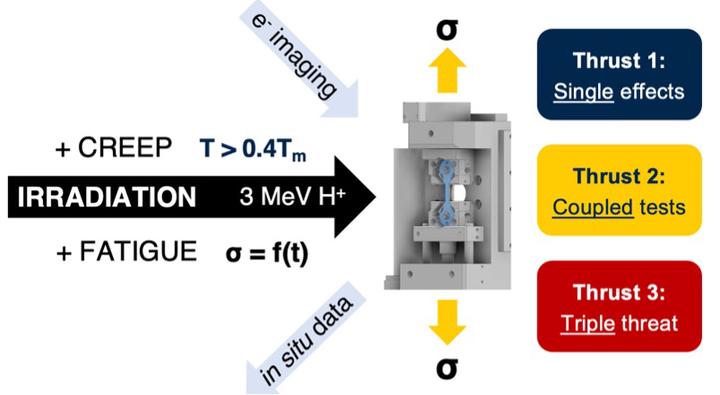Mechanism Driven Evaluations of Sequential and Simultaneous Irradiation-Creep-Fatigue Testing
 Image by C. Hirst
Image by C. HirstPrevious efforts towards deploying non-light water reactor (LWR) technologies in the modern era (<30 years) have highlighted the importance of generating, considering, and handling creep, creep rupture, and creep-fatigue data. Over the past decade, the Department of Energy (DOE) has placed considerable effort towards thermal creep and creep-fatigue data collection and review, but limited effort to date has focused on how irradiation can impact these results. Prior literature reports that radiation effects can either significantly reduce fatigue life or extend the lifetime, depending on temperature. Currently, there exists no standard way or method to perform reduced cost and accelerated irradiation-creep and irradiation-creep-fatigue testing. This project proposes to develop and use ion irradiation during both ex situ and in situ creep, fatigue, and creep-fatigue testing to analyze advanced reactor material responses under complex mechanical loading conditions in a low cost and accelerated manner. The objective of the proposed project is to develop fundamental understandings of the interplay between creep damage and fatigue damage under both simultaneous and sequential irradiation and mechanical testing, and ascertain the validity of both approaches. The scope of the project is constrained in both applied and mechanistic focus by determining the validity of sequential testing methodologies and by restricting the methods and analysis towards the impact of irradiation-induced effects on plastic deformation and microstructural evolution in tension-tension conditions. The work will focus on two materials of interest: Grade 91 and Alloy 709. Both alloys are under heavy consideration for use in non-LWR deployments as structural materials where creep and creep-fatigue can dictate the component lifetime during operation. The outcome will be a new systematic testing capability that enables the fundamental understanding on the role of irradiation in thermal creep-fatigue mechanisms. The systematic approach will also provide direct guidance to more costly but equally needed neutron irradiation campaigns on creep and creep-fatigue.